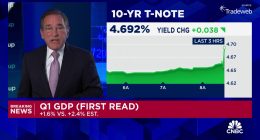
The Bank of Japan is likely to hold off from raising interest rates next week but investors expect the central bank to outline its response to rising inflationary pressures caused by the yen’s decline.
UBS, Morgan Stanley, Goldman Sachs and Barclays all predict that the BoJ will hold steady following a historic shift last month when it ended its negative interest rate policy and removed its cap on the 10-year Japanese government bond yield.
Governor Kazuo Ueda has signalled that future rate hikes will be gradual, saying more evidence is needed to ensure that rises in prices and wages are sustainable. Most analysts predict the next rate increase will be in either July or October.
But the yen has weakened to a fresh 34-year-low against the dollar following the BoJ’s most recent rate move, raising the risk that inflationary pressures caused by the increasing cost of imported goods will force the BoJ to tighten its policy at a faster pace than it would like.
“If the impact [of the weaker yen] becomes too big to ignore, it might lead to a change in monetary policy,” Ueda said on Thursday following a meeting of G20 finance ministers in Washington.
On Thursday the IMF said Asian central banks should reach policy decisions based on domestic inflation, rather than making them “overly dependent on anticipated moves by the Federal Reserve”.
Ueda may face “his first big challenge” if the yen keeps weakening while stock prices also fall, said Takahide Kiuchi, executive economist at Nomura Research Institute, noting the sharp slide in the Nikkei 225 equity index on Friday.
“The BoJ’s policy decision will become extremely difficult if it needs to keep an eye on both the risk of rising inflation due to the weaker yen and the risk of destabilisation in the economy and the financial system due to a decline in shares,” Kiuchi said. Kana Inagaki
Did US growth slow in the first quarter?
The US economy is expected to have expanded in the first three months of this year, albeit at a slower rate than the previous two quarters, as growth remains resilient even with interest rates at a 23-year high.
Data on Thursday is expected to show that the US economy grew by 2.3 per cent on an annualized basis, according to economists polled by Reuters, compared with 3.4 per cent in the previous quarter.
However, economists’ estimates are far lower than the Atlanta Fed’s GDP nowcast, which incorporates new data releases into its forecast in real time and which suggests GDP for the first quarter could be 2.9 per cent.
That estimate has increased significantly since blowout retail sales data for March, which sent bond yields higher and rattled currency markets as investors bet that a strong US economy would keep inflation — and therefore interest rates — high.
Also due next week is personal consumption expenditures data, the Fed’s preferred measure of price rises. The data is expected to show that headline inflation rose slightly to 2.6 per cent in March, year on year, from a rate of 2.5 per cent in February.
The core figure, which strips out the volatile food and energy components, is expected to fall to 2.7 per cent from 2.8 per cent. Both rates still remain far above the Fed’s 2 per cent target and represent a slowdown in progress on inflation, driven in part by a buoyant US economy.
New York Fed president John Williams at a conference on Thursday said he did not feel any “urgency” to cut interest rates because of current levels of inflation. The market is now expecting between one and two quarter-point cuts this year, compared with the six or seven cuts predicted in January. Kate Duguid
Will European business activity continue to rebound?
Investors will be looking out for signals on the strength of business activity in the UK and Europe on Tuesday, when the latest surveys of purchasing managers are published.
Economists polled by Reuters expect S&P Global’s composite purchasing managers’ index for the eurozone — a closely watched measure of business activity — to rise to 50.7 in April, up from the previous reading of 50.3. The index climbed above 50 in March, indicating an expansion, for the first time since May 2023.
Analysts expect the services sector to be buoyant while manufacturing activity is set to lag. “Manufacturing activity is improving but it’s still not positive,” said Tomasz Wieladek, an economist at investor T Rowe Price.
Economists also expect continued divergence between eurozone member states. Activity is expected to remain contracted in Germany and France, the largest economies in the bloc, but expand elsewhere.
The data will be closely scrutinised by the European Central Bank, which is expected to begin cutting interest rates in June as inflation falls close to target while growth remains sluggish. The IMF on Tuesday downgraded its forecast for growth in the eurozone this year to 0.8 per cent in 2024, from 0.9 per cent in January.
In the UK, where business activity has been more upbeat than in Europe, the pace of growth is expected to be little changed in April, with continued expansion in both the services and manufacturing sectors.
Economists polled by Reuters predict the UK’s composite purchasing managers’ index to come in at 52.7, a slight decline from last month’s reading of 52.8. Stephanie Stacey
Read More: World News | Entertainment News | Celeb News
FT









